
Summary of key points: -
- Financial market turn bearish on the US inflation outlook
- New Zealand’s economic fundamentals on the improve
- Australian dollar out-performs the NZ dollar amidst the US dollar onslaught
Financial markets turn bearish on the US inflation outlook
The global bond and FX markets have convinced themselves since the Donald Trump victory at the 5 November Presidential Election that the US annual inflation rate will increase to 3.00% in 2025 instead of remaining at the previously forecast 2.00%.
It is this change in expectation that has driven bond yields higher to 4.40% and the US dollar has appreciated back to the range highs of 107.50 on the USD Dixy Index. The buying of the US dollar has been buoyed by the now lower anticipated pace and amount of interest rate cuts by the Federal Reserve over the next 12 months.
What the financial market have conveniently set aside from their rationale is the fact that the Shelter housing rents) component of the CPI will continue to decline over the next six to 12 months, pulling the annual inflation rate down. The severely lagged nature of this Shelter CPI data reduces any doubt that the downward forces will not come through. There needs to be a reality check for the market view and that information is likely to come in the form of this Wednesday’s PCE inflation measure for the month of October. A monthly increase in inflation below the 0.20% forecast will be a timely reminder to the markets and the Fed members that there is no guarantee that US inflation increases just because there has been a change in the President. Adding to the argument that the markets may have read this incorrectly, is that fact that the Fed in their decision making on monetary policy over the last two years have been looking backwards in the rear-vision mirror at actual/historical economic data, rather than basing such decisions on forward projections of future economic conditions and inflation. Over coming months, it is highly likely that monthly inflation data prints on the lower side as lower energy/gasoline prices and lower housing prices far outweigh any price increases. It is highly unlikely that the Fed abruptly change their approach at this juncture in time to not look back but to look forward. Therefore, our expectation is that the Fed will continue to cut interest rates by 0.25% at each meeting over coming months as the US annual inflation rate (PCE measure) slides below 2.00%.
The Fed’s next meeting is 18 December, however softer than expected outcomes for inflation on 27th November and employment data for November on Friday 6th December could easily turn around the expectations and market pricing on future US inflation trends.
The latest bout of USD appreciation has followed US 10-year Treasury Bond yields higher, however as the chart below confirms the USD gains have far exceeded the rise in bond yields. As we have previously stated in recent columns, the time of year approaching December does increase the probability that the current long-USD position holders will soon take their profits and reverse the USD buying to USD selling.
The second US economic fundamental that drives the US dollar’s value over and above inflation trends is the size of the Federal Government’s budget deficit. Whilst the US dollar value can move away from the budget deficit trends (as a percentage of GDP – refer chart below) for extended periods of time, the economic reality is that if the deficit and debt is increasing, foreign investors into US Treasury Bonds will not invest if the US dollar value is too high. The USD depreciates when the budget deficit increases because the amount of capital inflows into the US reduces.
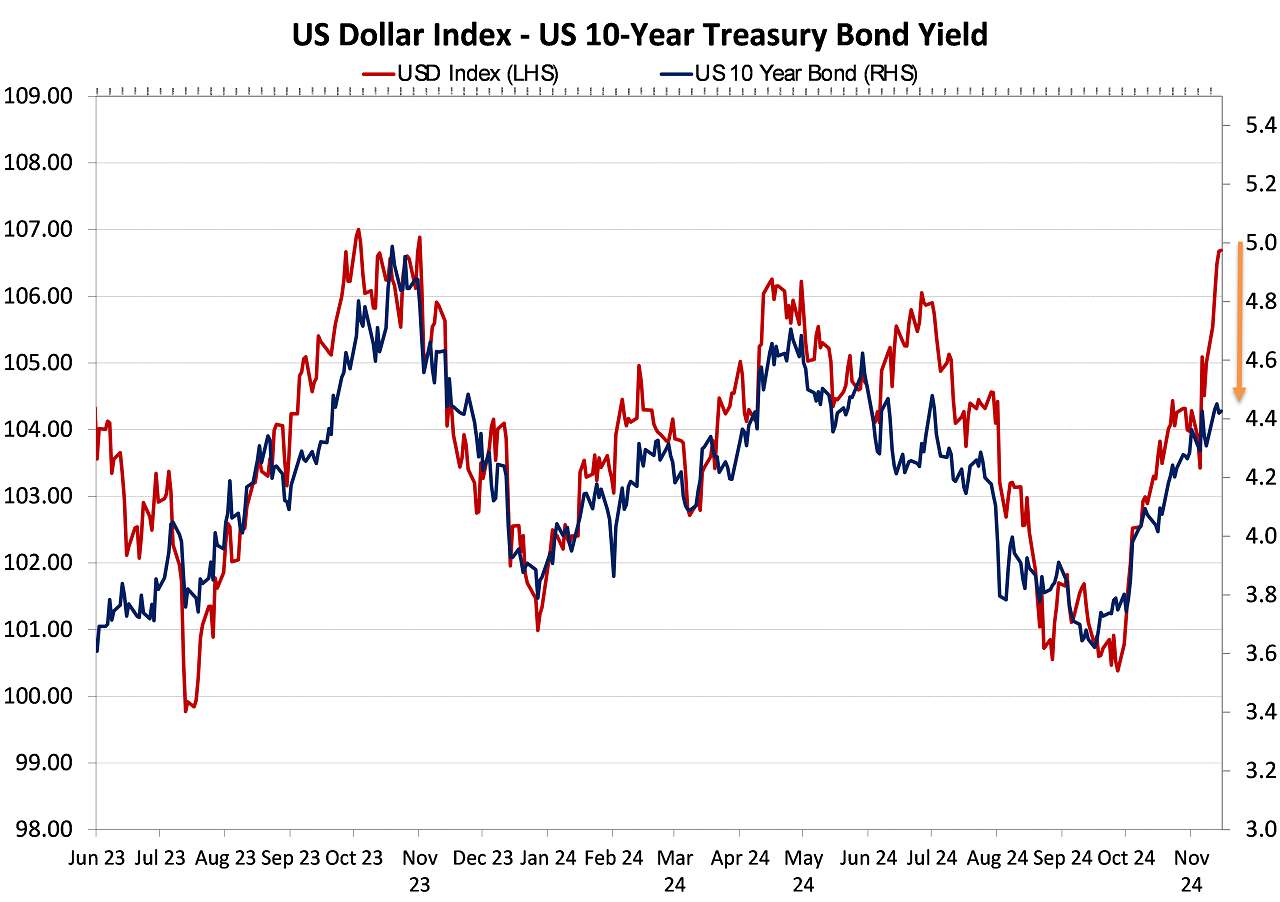
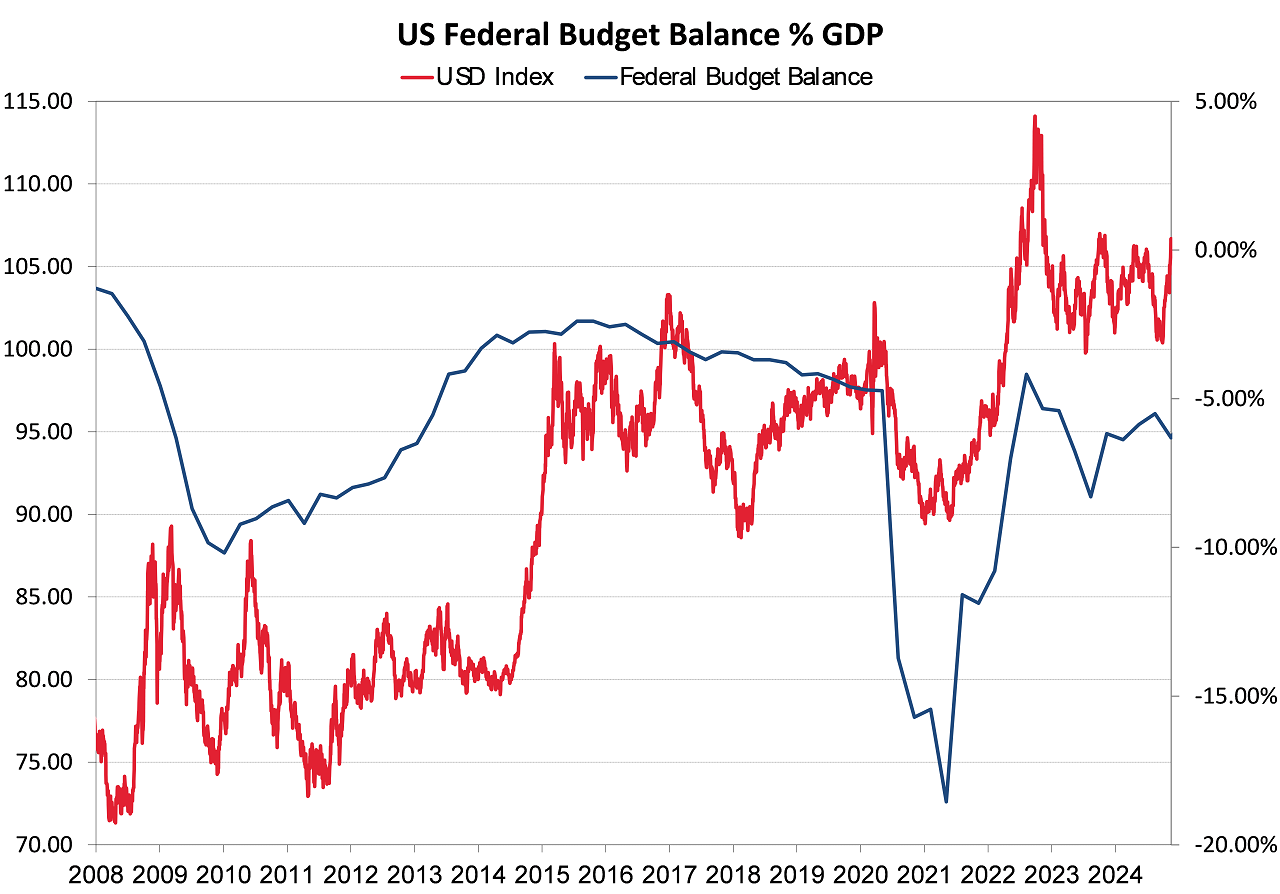
Given the Trump regime’s stated policies of tax cuts, Government spending increases and tariffs on imports, it seems likely that the US budget deficit as a percentage of GDP will increase from the current 6.00% to nearer 10.00% over coming years. That is not an environment that supports an even stronger US dollar value.
New Zealand’s economic fundamentals on the improve
Mainstream economists appear to be slow to recognise the quiet change occurring in the New Zealand economy. The nirvana combination of higher export commodity prices in the primary sector and a lower NZ dollar value below 0.6000 against the USD is driving rising prices, income and profits (refer first chart below). History tells us that most economic recoveries in New Zealand start in the rural provinces with increased spending and investment from improved farm incomes. Recent domestic economic data suggest the economy bottomed in its recession in June/July this year. A continuation of lower mortgage interest rates augers well for increased activity levels in retail spending and the housing market. Consumer confidence is improving and business confidence about the future in 2025 is sky high (refer to the second chart below).
The doom and gloom merchants will still attempt to convince you that we have major problems in our economy that we will take a long time to recover from. They always under-estimate the risk-taking ambitions of entrepreneurs in the local economy. The lower exchange rate values against the USD and AUD are major boons to competitiveness and pricing in export markets. According to the RBNZ and The Treasury the US and Chinese economies are going to slow further from here and that is a negative for our export sector. The rising export commodity prices suggest the opposite as consumer demand in our export markets remains solid or is improving (e.g. lamb exports into China).
Whilst our large twin deficits are not exactly positive for the NZ dollar currency value, the forward outlook of improvement is more positive. Current economist forecast of less than 1.00% GDP growth in the New Zealand economy next year appears at this point to be far too pessimistic, given the excellent export price equation. Our challenge will be to lift the export volumes to take advantage of the great prices.
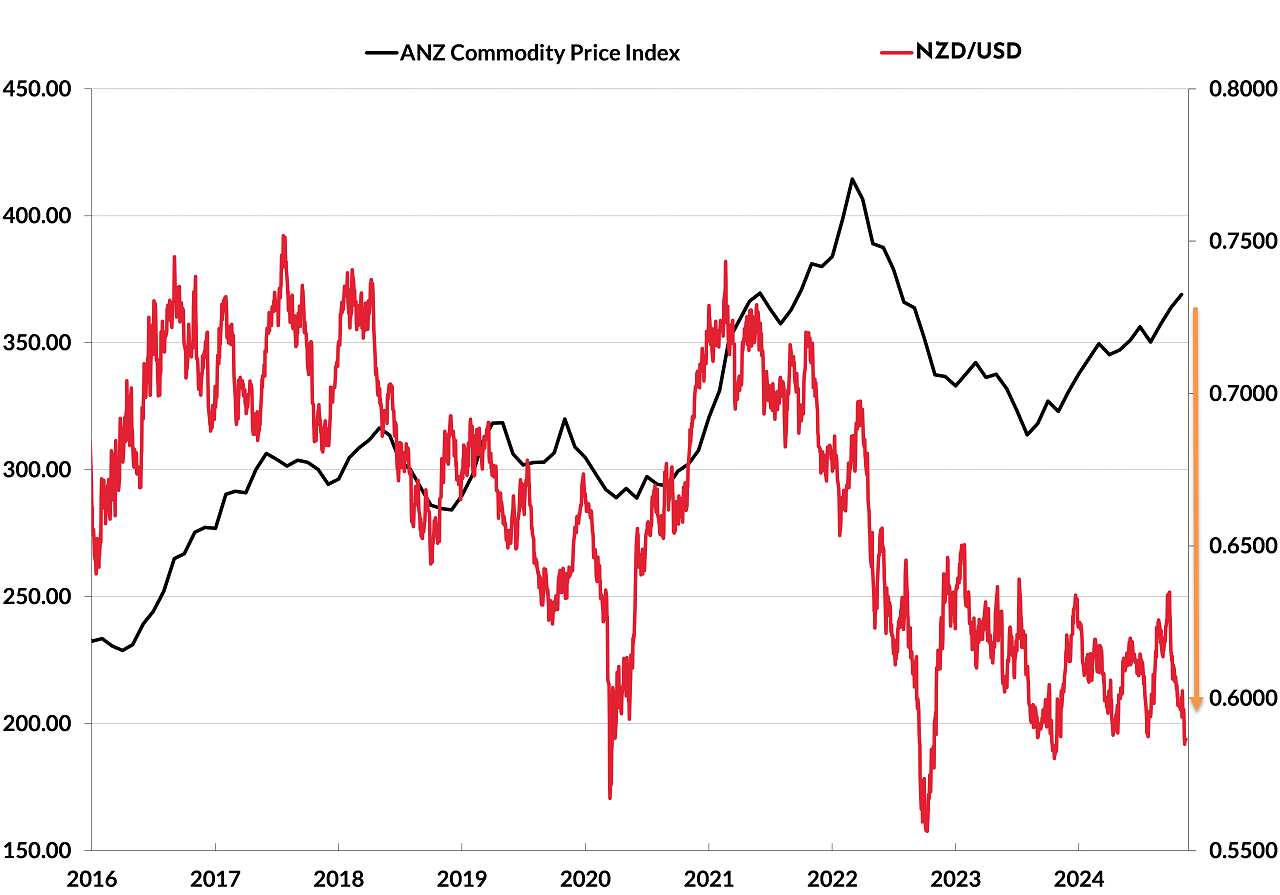
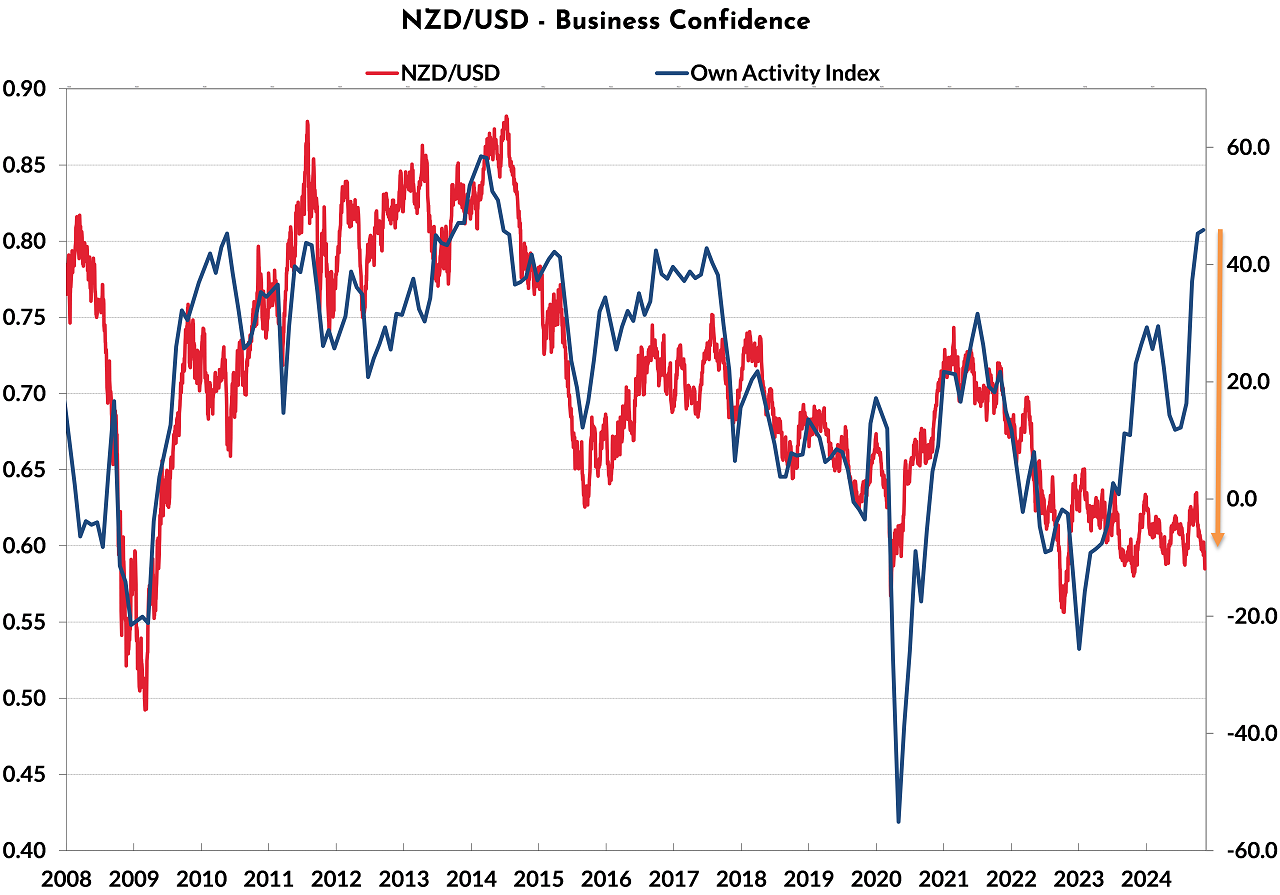
Australian dollar out-performs the NZ dollar amidst the US dollar onslaught
Like everyone else in the world, Australian business leaders, economists and the Reserve Bank of Australia are all struggling to decipher what the US Trump regime participants and economic policies mean for their own economy. In appointing a vaccine-denier as the head of health and a former hedge fund manager as Treasury Secretary, President-elect Donald Trump is telling the world that his cabinet is all about “who you know” rather than “what you know”. Time will tell on how much difference his cohorts and their policy changes will make to the direction of the US economy.
The prospect of a global trade war as a result of the Trump regime’s isolationist and protectionist policies, is always bad news for trading nations like New Zealand and Australia. However, it would be wise not to jump to negative conclusions until we actually see the detail of the US’s tariff policies.
Since early October when the USD buying commenced in earnest for the “Trump Trade” positioning, the Australian dollar has appreciated 4.40% against the USD from 0.6800 to 0.6500 (the same fall as the Euro against the USD). The Kiwi dollar, due its lower market liquidity on occasions, has depreciated by a larger 6.00% from 0.6200 to 0.5830. As a consequence, the NZD/AUD cross-rate has fallen away from the 0.9100 area to 0.8970. Over the last 10 years, the small number of times that the NZD/AUD exchange rate has dipped below 0.9000, it has proven to be a short-lived affair. The NZD seems to recover back upwards for whatever set of reasons. The sharply lower NZD/AUD cross-rate is fully justified as Australia hold their interest rates steady, whilst the RBNZ is proving to be the most aggressive central bank around the world in unwinding tight monetary conditions. A 0.50% cut to the OCR is expected this Wednesday, that expectation is already baked-in to the NZ dollar and local interest rate market pricing. Therefore, do not expect further NZD selling when the RBNZ deliver the 0.50% OCR reduction to 4.25%.
As the chart below shows, New Zealand’s two-year interest rate is now 1.00% below the Australian two-year rate, driving the NZD/AUD cross-rate lower.
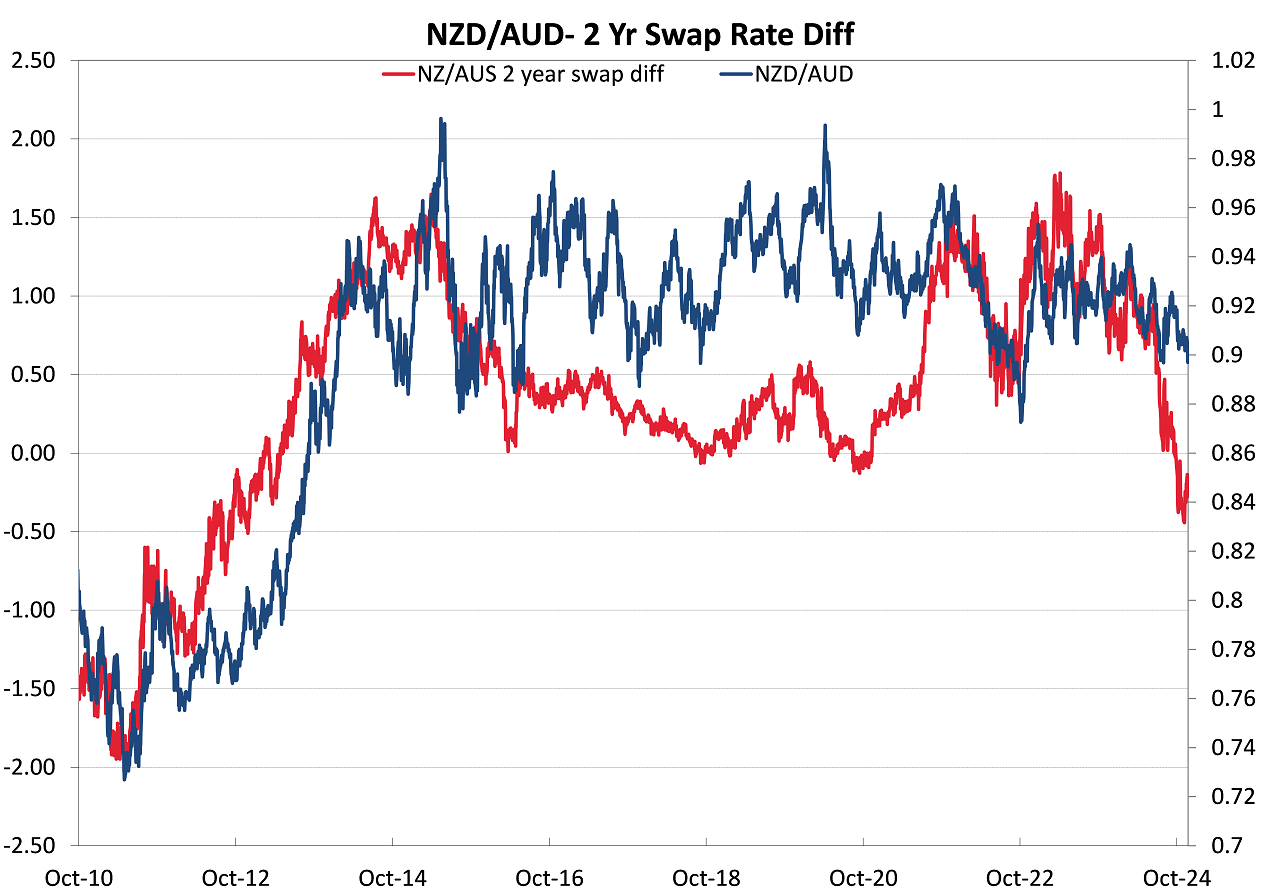
Daily exchange rates
Select chart tabs
*Roger J Kerr is Executive Chairman of Barrington Treasury Services NZ Limited. He has written commentaries on the NZ dollar since 1981.
3 Comments
Interesting.
Roger is often wrong - will be interesting to note how these latest predictions and pronouncements look in 6 months.
Thank you for the excellent analysis, Roger Kerr. Your articles always cover issues that other currency analysts seem to miss.
The higher American dollar if it holds would negate the propsed 10% tariff in the consumer pockets there is that. any higher will hurt. Trump in his first term frequently called for a lower US dollar, but I guess he can't have everything.
Yellen has sold treasuries to finance the US deficit with short term notes which are due to roll out and if rates don't fall the fact she chose not to tie in 30 year may make the next while interesting. I guess there will be a lot of blame passed around.




We welcome your comments below. If you are not already registered, please register to comment.
Remember we welcome robust, respectful and insightful debate. We don't welcome abusive or defamatory comments and will de-register those repeatedly making such comments. Our current comment policy is here.